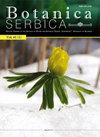对巴尔干半岛植物区系新记录的高山森林生态的深入了解
IF 1.1
4区 生物学
Q4 PLANT SCIENCES
引用次数: 1
摘要
对位于Stara Planina山的岩石生境进行了深入的植物区系和植物群落学调查,首次在巴尔干半岛记录到北极高山种Woodsia alpina (Woodsiaceae),这是塞尔维亚植物区系首次发现该物种和Woodsiaceae。这一新发现大大改变了它在东南欧分布的南部界限。在海拔1671 - 1718米之间的林带上发现了5个小亚种群,由几个到几十个标本组成。它们栖息在由二叠纪红色砂岩组成的几乎垂直的岩石裂缝中。高山杉木生长于湿润、微酸、营养贫乏的半荫蔽环境。它与苔藓、其他蕨类植物(Asplenium septentrionale、A. trichomanes、Asplenium ?互花草(Cystopteris fragile)和开花植物。聚类分析结果表明,塞尔维亚地区记录的白桫椤群落在区系组成上与欧洲其他国家的白桫椤有明显的区别。因此,有必要厘清该属在水蛭属(Asplenietea trichomanis, Br.-Bl)纲中的分类学等级。在Meier et Br.-Bl。(1934) Oberd. 1977和Androsacetalia vandellii目Br.-Bl。在Meier et Br.-Bl。1934年的未来研究。采用豪氏威马-奥尔夫- fresco模型对巴尔干地区的数据集进行分析,结果表明,在海拔、曝露和19个生物气候参数上,高山白杨具有狭窄的生态价值。另一方面,根据文献,由于其对寒冷气候和北极-高山类型分布的亲和力,它在欧洲的许多海拔高度都能成功生长。本文章由计算机程序翻译,如有差异,请以英文原文为准。
An insight into the ecology of Woodsia alpina newly recorded for the flora of the Balkan Peninsula
The arctic-alpine species, Woodsia alpina (Woodsiaceae), was recorded on the Balkan Peninsula for the first time as a result of an intensive floristic and phytocoenological investigation of the rocky habitats located on the Stara Planina Mt. The record represents the first finding of this species and the family Woodsiaceae in general for the flora of Serbia. This new finding shifts the southern limit of its distribution in Southeastern Europe significantly. Five small subpopulations, consisting of a few up to dozens of specimens, were found above the forest belt, at an elevation range between 1671 and 1718 m a.s.l. They inhabit fissures in what are almost vertical rocks composed of Permian red sandstone with western exposition. Woodsia alpina shows affinities to semi-shaded places, which are moisturerich, slightly acidic and poor in nutrients. It grows alongside mosses, other ferns (Asplenium septentrionale, A. trichomanes, Asplenium ? alternifolium, Cystopteris fragilis) and flowering plants. According to the results of the cluster analysis, the communities of W. alpina recorded in Serbia are clearly distinguished from those of this species in other European countries regarding their floristic composition. Hence, it is necessary to clarify the syntaxonomical rank of this association within the class Asplenietea trichomanis (Br.-Bl. in Meier et Br.-Bl. 1934) Oberd. 1977 and the Androsacetalia vandellii order Br.-Bl. in Meier et Br.-Bl. 1934 in future research. Applying Huisman-Olff-Fresco models on a dataset from the Balkans, it is revealed that W. alpina has narrow ecological valences regarding elevation, exposition and 19 bioclimatic parameters. On the other hand, according to the literature, it grows successfully in a wide range of elevations in Europe, as a result of its affinity to colder climates and the arctic-alpine type of distribution.
求助全文
通过发布文献求助,成功后即可免费获取论文全文。
去求助
来源期刊

Botanica Serbica
Agricultural and Biological Sciences-Plant Science
CiteScore
1.40
自引率
12.50%
发文量
17
审稿时长
34 weeks
期刊介绍:
Botanica Serbica publishes original research papers on all aspects of plant, fungal and microbial biology research including the disciplines of microbiology, mycology, lichenology, bryology, flora, vegetation, biogeography, systematics, taxonomy, plant biotechnology, plant cell biology, plant ecology, environmental plant biology, forestry, genomics, horticulture, limnology, metabolomics, molecular biology, proteomics, virology, plant conservation and protection, and wildlife and ecosystem management.
 求助内容:
求助内容: 应助结果提醒方式:
应助结果提醒方式:


